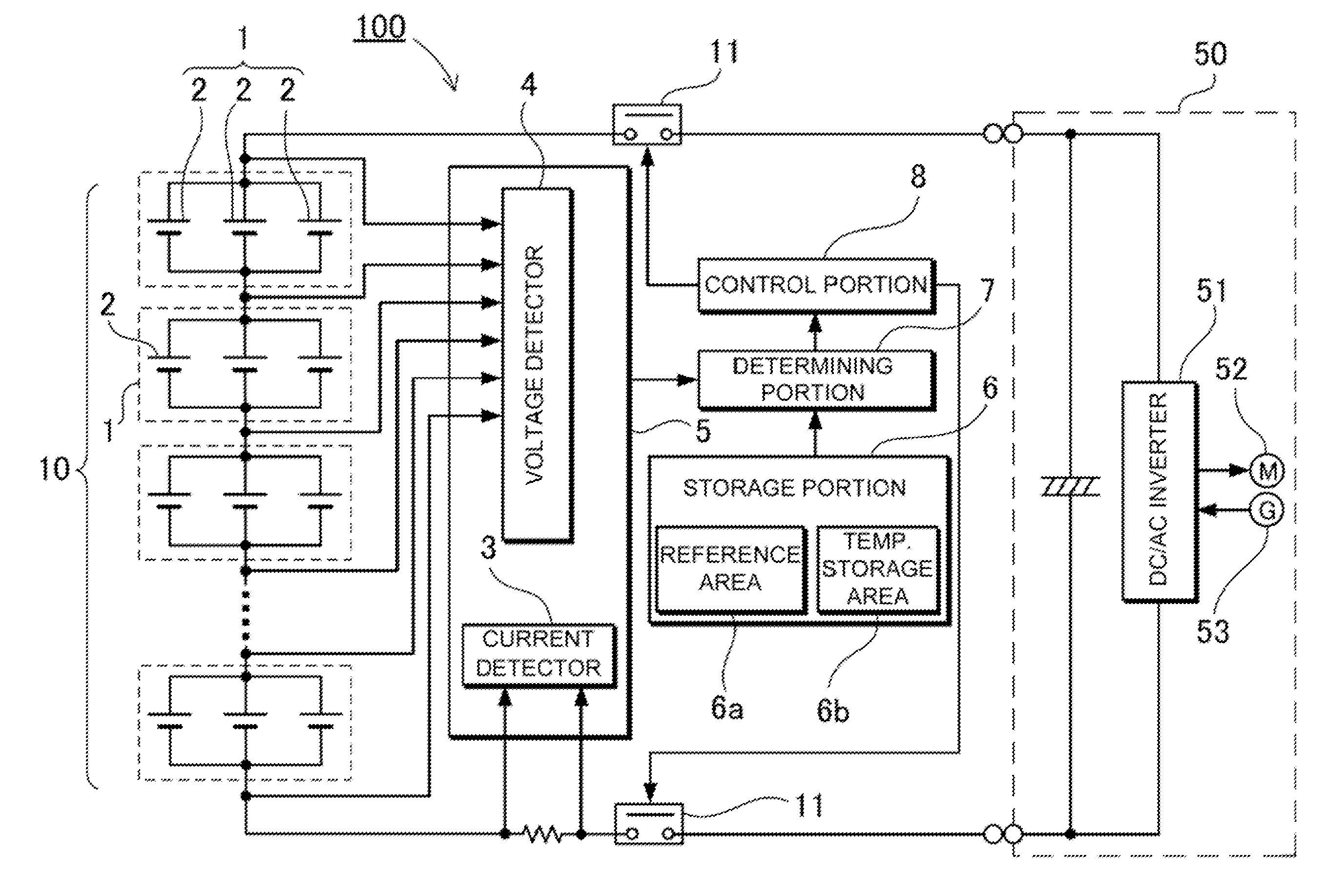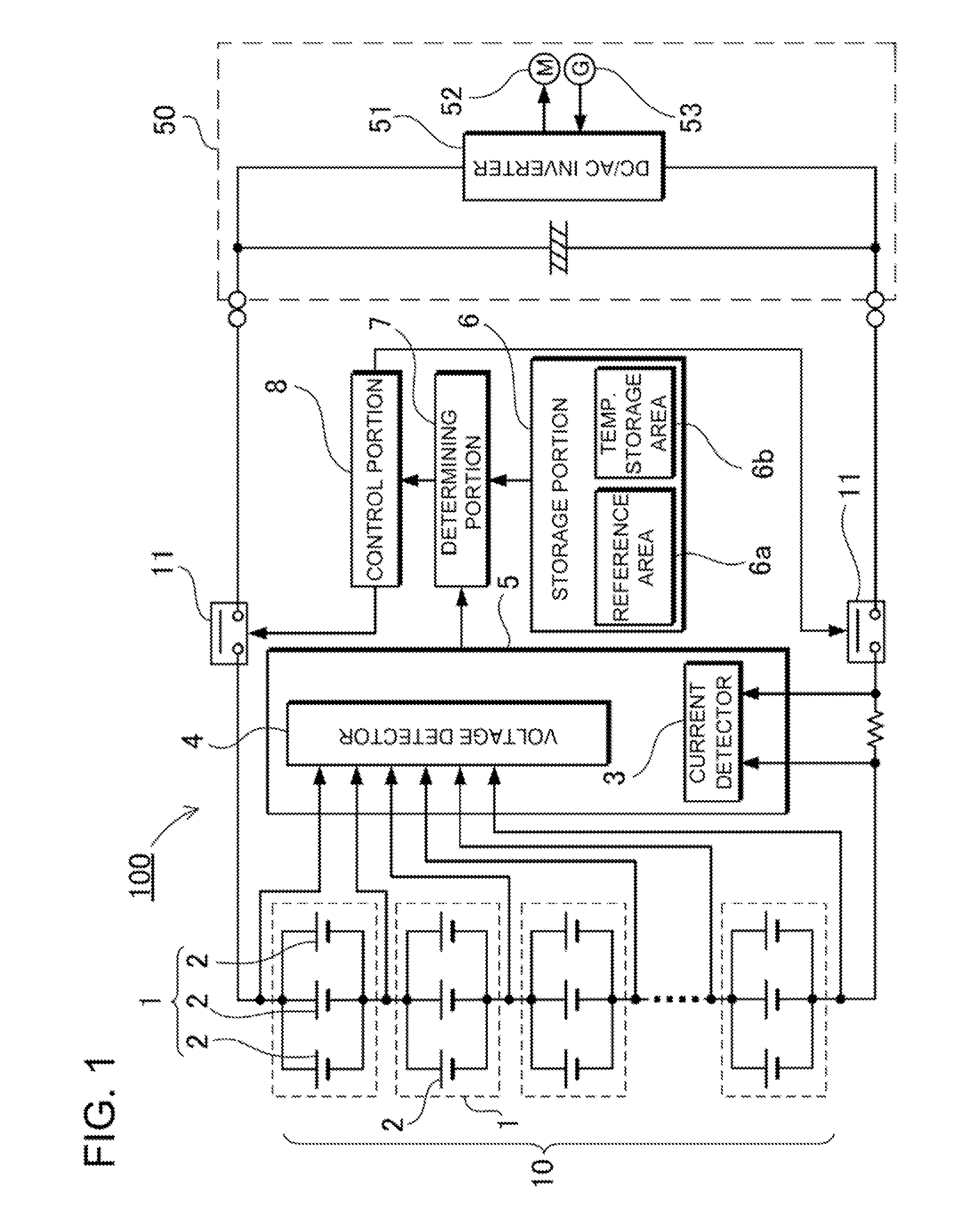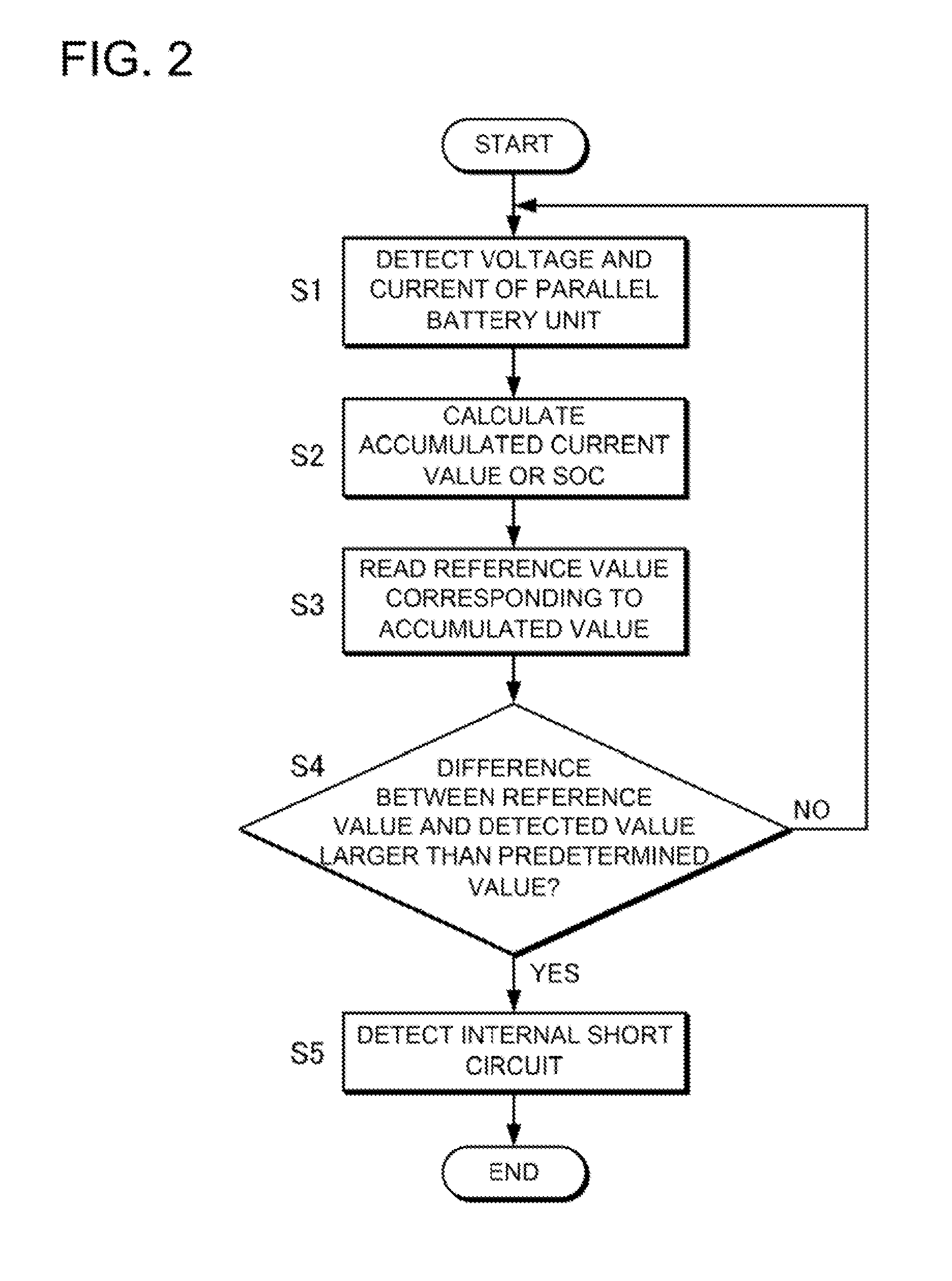To achieve the above object, a battery system according to a first aspect includes a
battery pack, a detecting portion, a storage portion, and a determining portion. The battery pack includes parallel battery units. Each of the parallel battery units includes a plurality of battery cells that are connected to each other in parallel. The parallel battery units are serially connected to each other. The detecting portion detects voltage and current of each of the parallel battery units. In addition, the detecting portion calculates the accumulated current value of each of the parallel battery units. The storage portion stores reference voltage values to be associated the accumulated current value of each of the parallel battery units calculated by the detecting portion. The determining portion reads, from the storage portion, one of the reference voltages corresponding to the accumulated value of each of the parallel battery units detected by the detecting portion. In addition, the determining portion compares the read reference voltage with the detection voltage of the each of the parallel battery units detected by the detecting portion. Thus, the determining portion determines that a
battery cell internal short circuit occurs if the difference between the detection voltage and the read reference voltage is larger than a predetermined value. Although, conventionally, it has been difficult to detect an internal short circuit in battery cells that are connected to each other in parallel, this battery system can effectively detect an internal short circuit in battery cells that are connected to each other in parallel.
A
battery cell internal short circuit detection method according to an eighth aspect for detecting a battery
cell internal short circuit in a battery system includes a detection step, a calculation step, a reading step, a comparison step, and a determination step. The battery system includes a battery pack that has serially-connected parallel battery units each of which includes a plurality of battery cells connected to each other in parallel. In the detection step, voltage and current of each of the parallel battery units are detected by a detecting portion. In the calculation step, the accumulated current value of each of the parallel battery units is calculated. In the reading step, from a storage portion that stores reference voltages, one of the reference voltages corresponding to the accumulated value of each of the parallel battery units is read. In the comparison step, the read reference voltage is compared with the detection voltage of the each of the parallel battery units detected by the detecting portion. In the determination step, it is determined that a battery
cell internal short circuit occurs if the difference between the detection voltage and the read reference voltage is larger than a predetermined value. Although, conventionally, it has been difficult to detect an internal short circuit in battery cells that are connected to each other in parallel, this method can effectively detect an internal short circuit in battery cells that are connected to each other in parallel.
The thus-constructed battery system can increase an output current and a
battery capacity by employing battery cells that are connected to each other in parallel, and can reliably determine whether an internal short circuit occurs in a battery
cell among the battery cells, which are connected to each other in parallel, whereby assuring higher safety. The operation of this battery system that can detect a very small internal short circuit in a battery cell is described with reference to FIG. 5. In this Figure, it is assumed that a very small internal short circuit occurs in the center battery cell. Since a current will flow from battery cells on the both sides into the center battery cell in that a very small internal short circuit occurs, the
voltage drop rate of the center battery cell is small. For this reason, it is not easy to detect occurrence of very small internal short circuit. In particular, such a very small internal short circuit in a battery cell does not always continuously occur but may temporarily occur in repeated charging / discharging operations. For this reason, if a very small internal short circuit temporarily occurs, it is difficult to detect this very small internal short circuit. However, an internally short-circuited battery cell has an actual charged capacity different from a normal battery cell. In addition, an internally short-circuited battery cell has an actual charged capacity corresponding to its actual charged capacity different from a normal battery cell. That is, the voltage of an internally short-circuited battery cell varies differently from a normal battery cell under charging operation. Also, deviation of the
voltage variation state of an internally short-circuited battery varies depending on the state of the battery cell. For example, in the case where a charging current is bypassed in the battery cell by an internal short circuit, currents decrease that flow in the battery cells on the both sides. In this case, the voltage rise of a parallel battery that includes such an internally short-circuited battery cell will be lower.
The aforementioned battery system stores the variation of voltage relative to capacity of a normal parallel battery unit under charging operation and discharging operation, specifically stores reference voltages as
normal variation of voltage relative to capacity. In battery pack charging / discharging operation, a charged or discharged capacity, and a voltage of a parallel battery unit are detected. In a parallel battery unit in that an internal short circuit does not occur in any of the battery cells, its detected voltage agrees with the reference voltage. However, in a parallel battery unit in that an internal short circuit occurs in any of the battery cell, since its actual charged / discharged capacity is deviated due to the internal short circuit, its detected voltage or the variation amount of its voltage will be different from the reference voltage or the reference
voltage variation amount. For this reason, after the charged / discharged capacity and voltage of a parallel battery unit are detected, the reference voltage corresponding to the detected charged / discharged capacity is compared with the detected voltage corresponding to the detected charged / discharged capacity, alternatively, the variation amount of detected voltage corresponding to the detected charged / discharged capacities is compared with the
voltage variation reference amount corresponding to the detected charged / discharged capacities. As a result, it is possible to detect a battery cell internal short circuit. in particular, in the case where battery system not only compares the reference voltage with the detected voltage of the parallel battery unit, but also compares the variation amount of detected voltage of the parallel battery unit with variation amount of reference voltages corresponding to the detected charged / discharged capacities, it is possible to reliably detect even a very small battery cell internal short circuit, and to safely charge /
discharge the battery pack. The reason is that, even if currents flow from the battery cells on the both sides into the internally short-circuited battery cell so that voltages of the battery cells in a parallel battery unit are equalized, such a very small battery cell internal short circuit can be detected.
 Login to View More
Login to View More  Login to View More
Login to View More 


